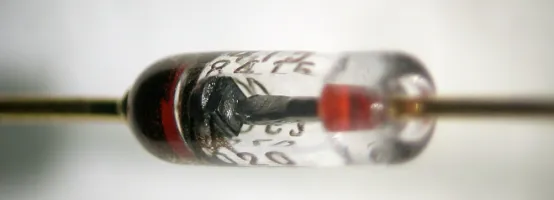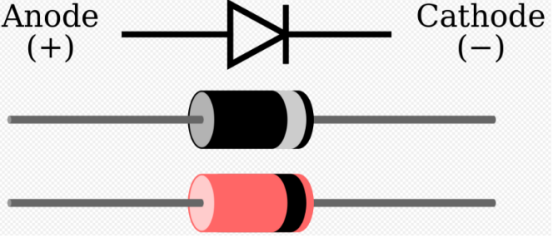Switching Diodes: Definitions, Principles, Applications, and Future Trends
The switching diode, often overlooked, is a silent hero of electronics, playing a crucial role in multiple industries. It swiftly switches electrical signals and safeguards sensitive components from voltage transients. Join us to explore the world of switching diodes, understanding their functions and diverse applications across industries, regardless of whether you're an electronics enthusiast, an experienced engineer, or simply curious about technology in today's world.

Figure1:Switching Diodes
I. Brief Definition of Switching Diode
A switching diode is an electronic component commonly used to control the flow of electrical current. It consists of two semiconductor materials, usually silicon or germanium, one of which is doped as an N-type semiconductor and the other as a P-type semiconductor. A switching diode has two pins, one is called the anode (A) or P terminal, and the other is called the cathode (K) or N terminal.
II. Review of the basic principles of switching diodes

Figure2:Typical Switching Diode package, thin ring represents cathode
A. How does the Switching Diode work?
The working principle of the Switching Diode is based on the semiconductor physical properties of the PN junction, where the PN junction is a structure composed of a P-type semiconductor and an N-type semiconductor. Here's how a switching diode works:
PN junction is formed: one pole is a P-type semiconductor, in which the number of electrons is relatively small, and the number of holes is large, and the other pole is an N-type semiconductor, in which the number of electrons is relatively large, but the number of holes is small. These two semiconductor materials are connected to each other through a PN junction, forming the structure of a switching diode.
Energy level difference: At the PN junction, due to the different doping of P-type and N-type semiconductors, an energy level difference is formed, that is, the potential difference between the electrons at the P terminal and the N terminal. This potential difference causes electrons to flow from the N-type region to the P-type region, and holes to flow from the P-type region to the N-type region.
Forward bias: When a forward voltage is applied to the switching diode, that is, the P terminal is positive and the N terminal is negative, electrons will be attracted to the P terminal, and holes will be attracted to the N terminal. In this way, electrons and holes will pass through the PN junction and combine, reducing the potential barrier of the PN junction and allowing current to pass. At this time, the switching diode is in a conducting state, allowing current to pass.
Reverse bias: When a reverse voltage is applied to the switching diode, that is, the P terminal is negative and the N terminal is positive, electrons will be repelled to the N-type region, and holes will be repelled to the P-type region, increasing the resistance of the PN junction. Barrier. This causes the switching diode to be in a cut-off state and current cannot pass through it unless the reverse voltage is large enough to break down the switching diode, at which time the current will suddenly increase, but this is usually an undesirable phenomenon.
In summary, the working principle of a switching diode is based on the potential difference of the PN junction. It is turned on by applying a forward voltage and turned off by applying a reverse voltage. This unidirectional conductivity enables switching diodes to have a variety of applications in circuits, including rectification, protection, switching, and signal shaping.
B. Features of switching diodes
Switching diodes (also called crystal switching diodes or simple switching diodes) have several properties that make them useful in electronic circuits. The following are the main characteristics of switching diodes:
Unidirectional conductivity: A switching diode allows current to pass in only one direction. When the voltage is forward, it is in a conducting state and current can flow; while when the voltage is reverse, it is in a cut-off state and current cannot pass. This property makes switching diodes very useful in rectifier circuits.
Low Voltage Drop: A switching diode has a relatively low forward voltage drop (also called dropout or threshold voltage), typically between 0.2 and 0.7 volts, which means it causes a very small voltage drop when in the conductive state , so the energy efficiency is higher.
Fast switching speed: Switching diodes have fast switching speeds and can quickly switch from the off state to the on state. This makes it suitable for high frequency applications such as radio frequency circuits.
For rectification: Due to their unidirectional conductivity and low voltage drop, switching diodes are often used in rectification circuits to convert alternating current into direct current. This is very important in power supplies.
For protection: Switching diodes can be used to prevent reverse voltage or overcurrent from causing damage to other components in the circuit. It can be used as part of a reverse polarity protection device or an overcurrent fuse.
For signal shaping: In some applications, switching diodes can be used for signal shaping, such as intercepting the input signal to a range above or below a certain voltage threshold for further processing.
Suitable for switching applications: Due to their fast switching characteristics, switching diodes are used in the construction of switching circuits such as pulse generators, sequential circuits, and digital logic gates.
Temperature sensitivity: The characteristics of switching diodes can be affected by temperature. Its electrical properties change with temperature, which needs to be considered in some applications.
Overall, the characteristics of switching diodes make them an important component in electronic circuits and are used in a variety of applications such as rectification, protection, switching and signal shaping.
C. The difference between switching diodes and ordinary diodes
There are some important differences in structure and working principle between switching diodes (Schottky diodes) and ordinary diodes (conventional PN junction diodes):
Materials and construction:
Switching diode: It's made of metal and semiconductor materials, forming a Schottky contact that reduces the P-N junction's potential barrier, lowering the forward voltage drop.
Ordinary diode: Composed of two different semiconductor materials, creating a typical PN junction potential barrier.
Forward voltage drop:
Switching diodes: Due to the presence of Schottky contacts, switching diodes have a relatively low forward voltage drop, typically between 0.2 volts and 0.5 volts.
Regular Diodes: The forward voltage drop of a regular diode is typically between 0.6 volts and 0.7 volts, which means it causes a larger voltage drop when conducting forward.
Reverse leakage current:
Switching diode: The reverse leakage current of the switching diode is relatively large because its structure allows more reverse current to pass.
Ordinary diodes: The reverse leakage current of ordinary diodes is relatively small because the electrical potential barrier of the PN junction limits the reverse current.
Switching speed:
Switching Diodes: Due to their structure and metal-semiconductor contacts, switching diodes generally have faster switching speeds and are suitable for high-frequency applications.
Ordinary diodes: Ordinary diodes switch relatively slowly and are suitable for low frequency applications.
application:
Switching diodes are commonly used in high-speed switching circuits, radio frequency applications, high-frequency rectification, and other applications that require fast switching and low forward voltage drop.
Ordinary diodes are used in rectification, protection, reverse polarity protection, switching power supplies and general electronic circuits.
In general, there are significant differences in structure, electrical characteristics and applications between switching diodes and ordinary diodes. Therefore, specific circuit requirements and application environments need to be considered when selecting diodes.
III. Application of Switching Diodes in Power Electronics

Figure3:Switching Diode
Switching Diodes have a variety of important applications in power electronics, which contribute to the effective control and management of power systems. The following are some applications of Switching Diodes in power electronics:
A. Rectifier
Switching Diodes are used to convert AC power to DC power, which is a basic requirement for almost all electronic devices. They have fast switching speeds, which help reduce energy loss during rectification and improve rectification efficiency.
B.Switching power supply
In switching power supplies, Switching Diodes are used to control the on and off switching tubes (such as MOSFET or IGBT) to help achieve high-efficiency power conversion. They also help reduce magnetically induced peak currents in the power supply, reducing the size and weight of the power supply.
C.Inverters and converters
Switching Diodes are used in inverters and converters to convert DC power to AC power. These applications are widely used in solar inverters, wind energy systems and industrial power supplies.
D. Power factor correction
Switching diodes can also be used in power factor correction circuits to improve the power factor of the power supply, reduce harmonics, and reduce power loss.
E.Power management
In electronic devices, such as computers, tablets, and cell phones, Switching Diodes are used to manage the battery charging and discharging process, extending battery life and improving power efficiency.
F. Electric vehicle charger
In electric vehicle chargers, Switching Diodes are used to control the conversion of electrical energy to ensure a highly efficient charging process.
G. Uninterruptible power supply (UPS)
Switching Diodes are used in UPS systems to provide reliable power during power outages. They help ensure that power is switched quickly to keep critical equipment running.
H.Power switch
In power switching circuits, Switching Diodes are used to quickly cut off the circuit to prevent overvoltage or short circuit conditions and protect electronic equipment.
I. High temperature and high pressure applications
Some Switching Diodes are designed for applications in high-temperature and high-pressure environments, such as aerospace, the petroleum industry, and nuclear energy systems.
In summary, Switching Diodes play a key role in power electronics, helping to improve the efficiency, stability and reliability of power systems while also supporting the development of renewable energy and energy management. The continued evolution of these application areas will continue to drive innovation and improvement in Switching Diodes.
Ⅳ. Trends and future development of cross-industry applications of Switching Diodes
Trends and future developments in cross-industry applications of Switching Diodes include:
Modern technology trends: With the continuous development of emerging technologies, such as 5G communications, the Internet of Things, and electric transportation, the demand for Switching Diodes will continue to increase to meet the requirements of high frequency, high efficiency, and fast switching.
Emerging Application Areas: Switching Diodes will expand into new application areas such as quantum computing, biomedical devices and wearable technology to support innovative electronic products and systems.
Environmental protection and energy efficiency direction: As sustainability and energy efficiency become the main focus, the design of Switching Diodes will pay more attention to energy efficiency, low power consumption and environmental protection to meet future environmental protection regulations and market demands.
Ⅴ. Summary: Switching Diodes
Switching diodes are crucial in electronics and have a wide range of applications in energy, communication, medical, transport, industrial control, and aerospace. Their ongoing development offers industry professionals opportunities to innovate and enhance technology, efficiency, and adapt to changing demands. In the future, switching diodes will remain instrumental in diverse industries, driving science and technology advancement.
Related Articles
Principle, Structure and Fault Analysis of Centrifugal Switch
Switching Diodes: Definitions, Principles, Applications, and Future Trends
Exploring Solenoid Switches: Principles and Applications
Operation & Fault Handling of High Voltage Switchgear Explained
Load Break Switch : Principle and Its Applications
Zero Speed Switch : Principle & Its Applications
Operation & Fault Handling of High Voltage Switchgear Explained
Exploring Solenoid Switches: Principles and Applications
Principle, Structure and Fault Analysis of Centrifugal Switch
Do Capacitors Get Hot? [All You Know]
Temperature Coefficient of Resistance
Variable Capacitors: A Complete Guide
Unveiling Polypropylene Capacitors: Principles, Applications, and Future Trends
The Automotive PCB Market Seizes Fresh Opportunities










